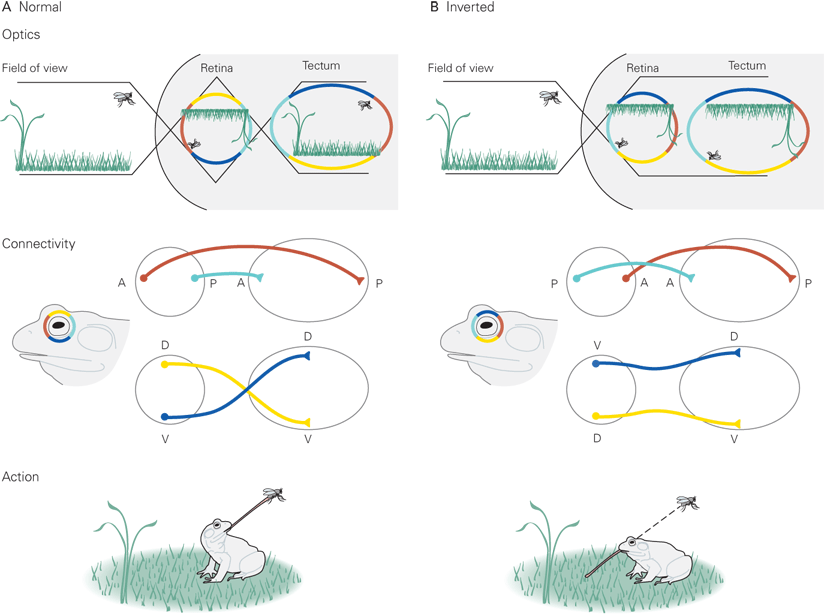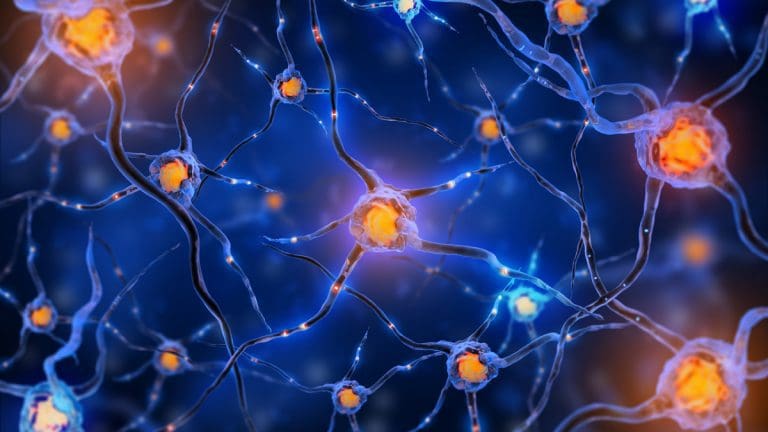Neurons are believed to establish neuronal connections through innate predetermined programs during the developmental process of the brain. It’s also believed that neurons gravitate to areas of attraction and move away from areas of repulsion in a theory known as the chemoaffinity hypothesis. The Chemoaffinity hypothesis claims that neurons first make connections with their targets based on interactions with specific molecular markers and, therefore, that the first wiring diagram of an organism is indirectly determined by its genotype.
These markers are created during cellular differentiation and aid not just with synaptogenesis, but also act as guidance cues for their individual axon. The development of the mature nervous system formations demands axons to navigate to their correct targets in order to establish neuronal connections or synaptic connections. Growing axons create highly motile structures, known as growth cones, which direct the axon to its goal. They do it by responding to specific guidance molecules that either attract or repel the growth cone.
Table of Contents
The Theory of Neuronal Connections
The concept that axons are directed principally by molecular determinants, rather than mechanical determinants, such as cells, extracellular material and other neurons, was established by Roger Wolcott Sperry, a neuropsychologist and neurobiologist, in 1963. However, it was not until the discovery of guidance molecules including netrins, semaphorins, ephrins and Slits, that Sperry’s chemoaffinity hypothesis became widely recognized as a prevalent mechanism for guidance of not only axons, but of all cells.
In 1981, Roger Sperry received the Nobel Prize for Physiology or Medicine for his discoveries concerning the functional specialization of the cerebral hemispheres. He performed studies on patients with epilepsy in whom the corpus callosum, or the bundle of axons fibers which connects the two brain hemispheres, was severed to stop seizures. A number of tests and evaluations revealed the way both brain hemispheres hold independent streams of conscious awareness, perceptions, thoughts and memories, and most fundamentally, that neuronal connections are formed and preserved with a high degree of precision.
Having demonstrated that the institution of specific neuronal connections is fundamental to the overall function of the brain, Sperry turned to look at how these connections are created, and used his chemoaffinity theory to describe how axons find the right target during the development of the brain. Others had raised the possibility that compound determinants might function in axon guidance, but it was Sperry that supplied the direct histological evidence and proposed the chemoaffinity hypothesis for axon guidance.
Roger Sperry and his Chemoaffinity Hypothesis
Roger Wolcott Sperry pioneered the inception of the Chemoaffinity Hypothesis after the 1960’s in a series of elegant experiments employing the retinotectal system of the African Clawed Frog, he sectioned the optic nerves and steered the eyes 180 degrees. He wished to know whether vision would be ordinary following regeneration or if the animal would eternally see the world ‘upside down’. If the latter held true, this could reveal that the nerves were somehow guided back to their original sites of termination; however, restoration of normal eyesight would mean that the nerves had resumed at new sites. Sperry showed that these creatures did indeed view the world ‘upside down’.

According to the experiment, initial eye orientation gives that the top of the eye is Dorsal, and the underside is Ventral. Post-operation, the “top” of the eye is now Ventral, and the base is Dorsal. After a food source was supplied, the frog extended its tongue, meaning that the Dorsal-Ventral orientation of the eye still remained. In follow up experiments, the eye was dispersed and rotated 180° and the optic nerve was also cut to determine if this could affect the Dorsal-Ventral orientation. The results were identical. It was those studies which directed Sperry to suggest that complicated chemical codes, under genetic control, direct axons to their targets, his chemoaffinity hypothesis.
In his first theory, Sperry proposed that distinct cells bear different cell-surface proteins that serve as markers, a notion that demanded an unsatisfactorily high variety of proteins. He revised his model suggesting that double gradients of guidance cues in the afferent and target areas would enable proper axon targeting. There is now extensive experimental data to support the chemoaffinity hypothesis, as well as the requirement for gradients of receptor and/or ligand, such as ephrins and Eph receptors, in the projection and target regions is well established.
Roger Wolcott Sperry concluded that every individual optic nerve and tectal neuron used some kind of chemical markers that dictated their connectivity through development. He concluded that if the eye had been rotated, each optic fiber and every tectal neuron possessed cytochemical labels that uniquely denoted their neuronal kind and place and that optic fibers may use these labels to navigate to their own matching target cell, hence the visuomotor impairment. Although certain aspects and details about Sperry’s model are unproven or incorrect, the basic notion of this chemoaffinity hypothesis has become dogma in developmental neurobiology.

Dr. Alex Jimenez’s Insight
Over the years, the principle to understand the establishment of neuronal connections has continued throughout the field of neurophysiology as well as prenatal development of the brain. Neuronal connections are believed to be established during the migration of growth cones guided by extracellular guidance cue gradients. Although this theory has been revisited countless of times, Roger Sperry was the first to explain how axons navigate to their correct targets in his chemoaffinity hypothesis. Countless experimental and clinical data now exists to support the chemoaffinity hypothesis.
The scope of our information is limited to chiropractic as well as to spinal injuries and conditions. To discuss the subject matter, please feel free to ask Dr. Jimenez or contact us at 915-850-0900 .
Curated by Dr. Alex Jimenez
Additional Topics: Sciatica
Sciatica is medically referred to as a collection of symptoms, rather than a single injury and/or condition. Symptoms of sciatic nerve pain, or sciatica, can vary in frequency and intensity, however, it is most commonly described as a sudden, sharp (knife-like) or electrical pain that radiates from the low back down the buttocks, hips, thighs and legs into the foot. Other symptoms of sciatica may include, tingling or burning sensations, numbness and weakness along the length of the sciatic nerve. Sciatica most frequently affects individuals between the ages of 30 and 50 years. It may often develop as a result of the degeneration of the spine due to age, however, the compression and irritation of the sciatic nerve caused by a bulging or herniated disc, among other spinal health issues, may also cause sciatic nerve pain.

EXTRA IMPORTANT TOPIC: Sciatica, Pain, Symptoms and Causes
MORE TOPICS: EXTRA EXTRA: El Paso Spine Center | Back Pain Treatment
Post Disclaimer
Professional Scope of Practice *
The information on this blog site is not intended to replace a one-on-one relationship with a qualified healthcare professional or licensed physician and is not medical advice. We encourage you to make healthcare decisions based on your research and partnership with a qualified healthcare professional.
Blog Information & Scope Discussions
Welcome to El Paso's Premier Wellness and Injury Care Clinic & Wellness Blog, where Dr. Alex Jimenez, DC, FNP-C, a board-certified Family Practice Nurse Practitioner (FNP-BC) and Chiropractor (DC), presents insights on how our team is dedicated to holistic healing and personalized care. Our practice aligns with evidence-based treatment protocols inspired by integrative medicine principles, similar to those found on this site and our family practice-based chiromed.com site, focusing on restoring health naturally for patients of all ages.
Our areas of chiropractic practice include Wellness & Nutrition, Chronic Pain, Personal Injury, Auto Accident Care, Work Injuries, Back Injury, Low Back Pain, Neck Pain, Migraine Headaches, Sports Injuries, Severe Sciatica, Scoliosis, Complex Herniated Discs, Fibromyalgia, Chronic Pain, Complex Injuries, Stress Management, Functional Medicine Treatments, and in-scope care protocols.
Our information scope is limited to chiropractic, musculoskeletal, physical medicine, wellness, contributing etiological viscerosomatic disturbances within clinical presentations, associated somato-visceral reflex clinical dynamics, subluxation complexes, sensitive health issues, and functional medicine articles, topics, and discussions.
We provide and present clinical collaboration with specialists from various disciplines. Each specialist is governed by their professional scope of practice and their jurisdiction of licensure. We use functional health & wellness protocols to treat and support care for the injuries or disorders of the musculoskeletal system.
Our videos, posts, topics, subjects, and insights cover clinical matters and issues that relate to and directly or indirectly support our clinical scope of practice.*
Our office has made a reasonable effort to provide supportive citations and has identified relevant research studies that support our posts. We provide copies of supporting research studies available to regulatory boards and the public upon request.
We understand that we cover matters that require an additional explanation of how they may assist in a particular care plan or treatment protocol; therefore, to discuss the subject matter above further, please feel free to ask Dr. Alex Jimenez, DC, APRN, FNP-BC, or contact us at 915-850-0900.
We are here to help you and your family.
Blessings
Dr. Alex Jimenez DC, MSACP, APRN, FNP-BC*, CCST, IFMCP, CFMP, ATN
email: coach@elpasofunctionalmedicine.com
Licensed as a Doctor of Chiropractic (DC) in Texas & New Mexico*
Texas DC License # TX5807
New Mexico DC License # NM-DC2182
Licensed as a Registered Nurse (RN*) in Texas & Multistate
Texas RN License # 1191402
ANCC FNP-BC: Board Certified Nurse Practitioner*
Compact Status: Multi-State License: Authorized to Practice in 40 States*
Graduate with Honors: ICHS: MSN-FNP (Family Nurse Practitioner Program)
Degree Granted. Master's in Family Practice MSN Diploma (Cum Laude)
Dr. Alex Jimenez, DC, APRN, FNP-BC*, CFMP, IFMCP, ATN, CCST
My Digital Business Card



